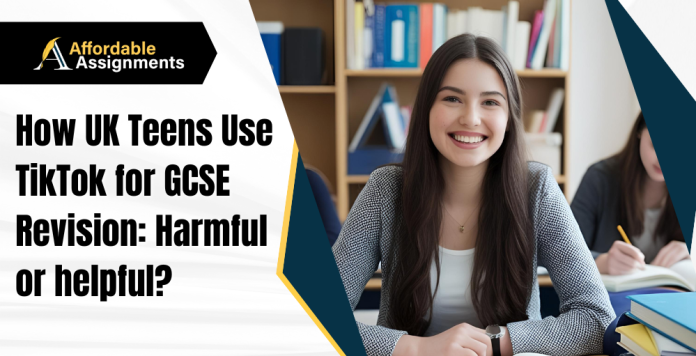In the changing digital era, the landscape of academic revision has changed significantly. TikTok is among the most unanticipated and controversial tools currently entering the study industry, renowned largely for viral humor as well as dance trends. Nowadays, a growing number of UK teenagers are using this particular social networking app for GCSE revision. Do you feel this trend reflects an intelligent digital adaptation or a dangerous shortcut that undermines academic depth?
The Rise of the TikTok Study Content
The effect of TikTok on teenagers is indisputable. The platform directly taps into just how young minds consume content via its brief, visually appealing videos. Throughout the exam season, searches for “GCSE tips,” “study with me,” as well as “revision hacks,” skyrocket. ” A few of the creators are competent instructors or college students, and provide bite-sized instruction on English literature, science mnemonics, or mathematics formulas.
This particular format is popular with teenagers as it’s simple to understand and accessible. Conventional revision methods can become overwhelming, particularly for people who are facing exam stress or attention problems. A 60-second TikTok, on the other hand, which breaks Shakespeare’s metaphors or even clarifies the Theorem of Pythagoras, might feel more digestible. It’s a tiny amount of microlearning education.
Critics have expressed concerns about the quality as well as the depth of educational content on TikTok, in spite of the fact that it is very popular. TikTok’s content is not peer-reviewed, and accuracy varies considerably, as opposed to platforms created for structured learning. This raises the issue of whether teenagers are absorbing knowledge or simply enjoying themselves under the illusion of productivity.
TikTok: Benefits for Revision
TikTok does what textbooks usually do not: motivates from an engagement viewpoint. Several students find it less nerve-racking to view revision videos from their fellow students. The algorithm of TikTok also encourages repeated exposure to the same content, and that could boost memory recall. Teachers may even make use of the platform to provide revision rhymes or mini-lessons. This can help to bridge the gap between conventional teaching techniques and Gen Z learning habits. Several teachers point out that TikTok encourages even reluctant students to engage with material; therefore, it deserves a place in contemporary revision methods.
It’s risky to over-rely on the platform. The majority of videos provide brief introductions of the subject matter instead of deep explanations. The students might not acquire the abilities in critical thinking or writing necessary for essays. When confronted with complicated assignments, a lot of teenagers continue to look for the help of traditional academic platforms, including an assignment help UK, especially during their last years of college when the stakes are high.
Dangers associated with Misinformation and distraction
The dissemination of misinformation is one of the main problems with TikTok used in GCSE preparation. Anybody is able to claim expertise with no sort of educational verification procedure. Misunderstood facts or even flawed techniques are able to easily fool students, particularly those who do not cross-check what they find out.
The addictive nature of the site could be detrimental even if the content is accurate. A student might log on to view one informative video and wind up scrolling through unrelated material for several hours. The distinction between study and procrastination gets blurred.
One other issue is the fact that TikTok concentrates much more on entertainment as opposed to deep learning. Due to the very short time of a video, creators usually oversimplify concepts, leaving nuance or context behind. What this means is that students might not do their very best on extended answers or essay questions that call for a high level of clarity, depth, and argument.
These problems have caused several teenagers to depend on academic support services such as dissertation writing services UK, particularly when switching from GCSEs to A-levels or original university courses. These services offer the level as well as the breadth of help required for complicated academic needs that a TikTok clip cannot meet.
A Way Forward for Blending Entertainment with Education
A far more complex view of TikTok might be needed, instead of viewing it as either intrinsically harmful or helpful. The platform may complement traditional revision techniques when utilized responsibly. For instance, students could look to TikTok videos as brief refreshers or motivation before diving into previous papers or even books.
Parental and teacher support is the key. In order to lessen the risks, motivating teens to verify what they are learning as well as integrating it with fully-fledged materials is crucial. Schools are increasingly implementing digital literacy courses to help students learn the best way to critically assess online material.
Collaboration among educational institutions and content creators is also growing. TikTok-verified teachers are now producing syllabus-aligned videos, and several apps are embedding TikTok-like videos to their learning platforms. This particular evolution mirrors a hybrid model in which formal and informal learning merge.
However, if the pressure builds up during exams, a lot of students continue to search for last-minute guidance through platforms providing online exam help or even writing support. These services, although controversial, try to fill the voids created by overly simplified digital content.
Conclusion
To conclude, TikTok is transforming the way in which UK teenagers study for their GCSEs, and it is neither a total solution nor an academic threat alone. TikTok could serve as a motivating springboard for deeper learning if it’s the correct balance. Nevertheless, students frequently depend on conventional sources or look for do my assignment for me when due dates are getting close. For teachers as well as parents, the task would be helping students make use of these digital tools as part of a wider, thoughtful learning strategy.

